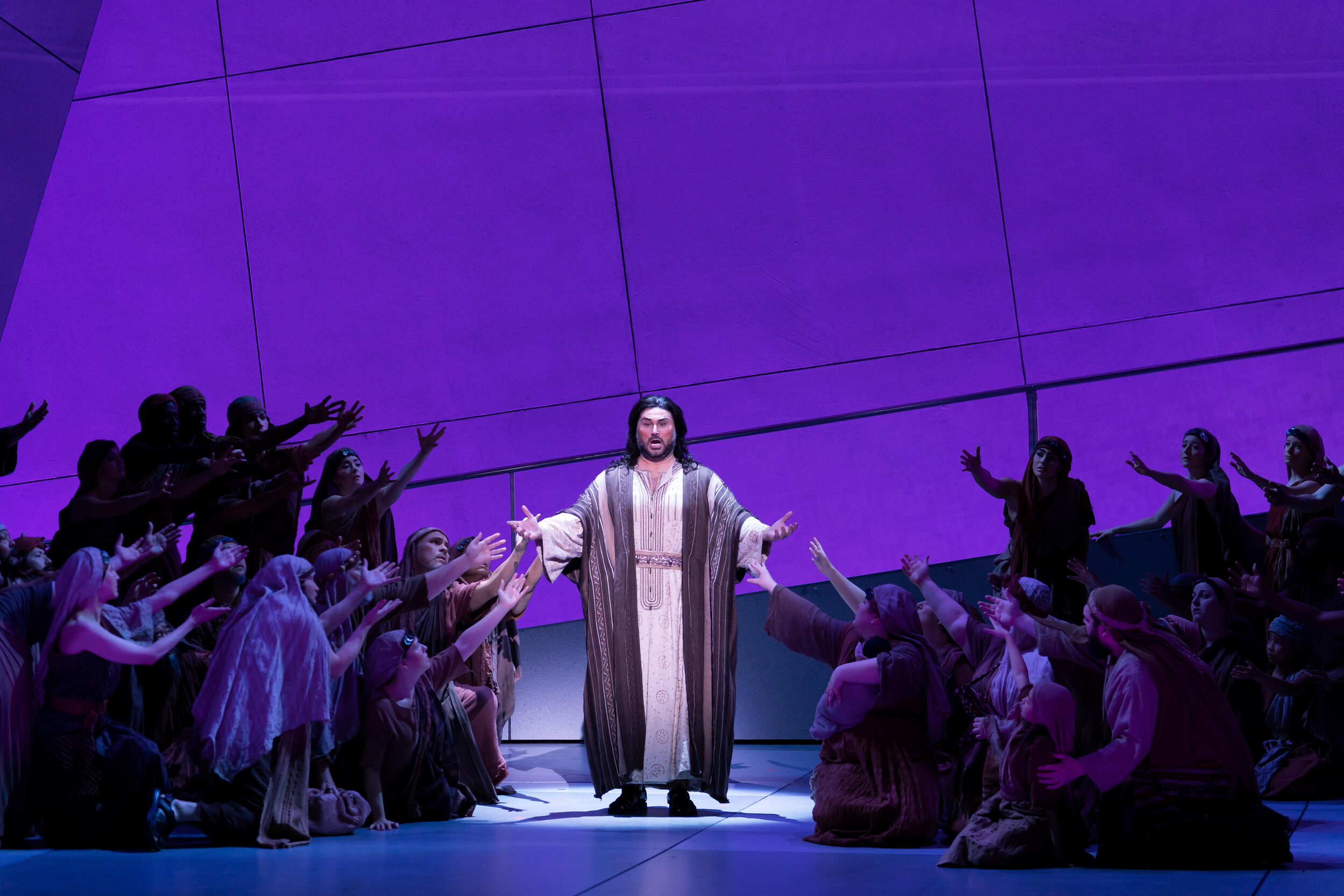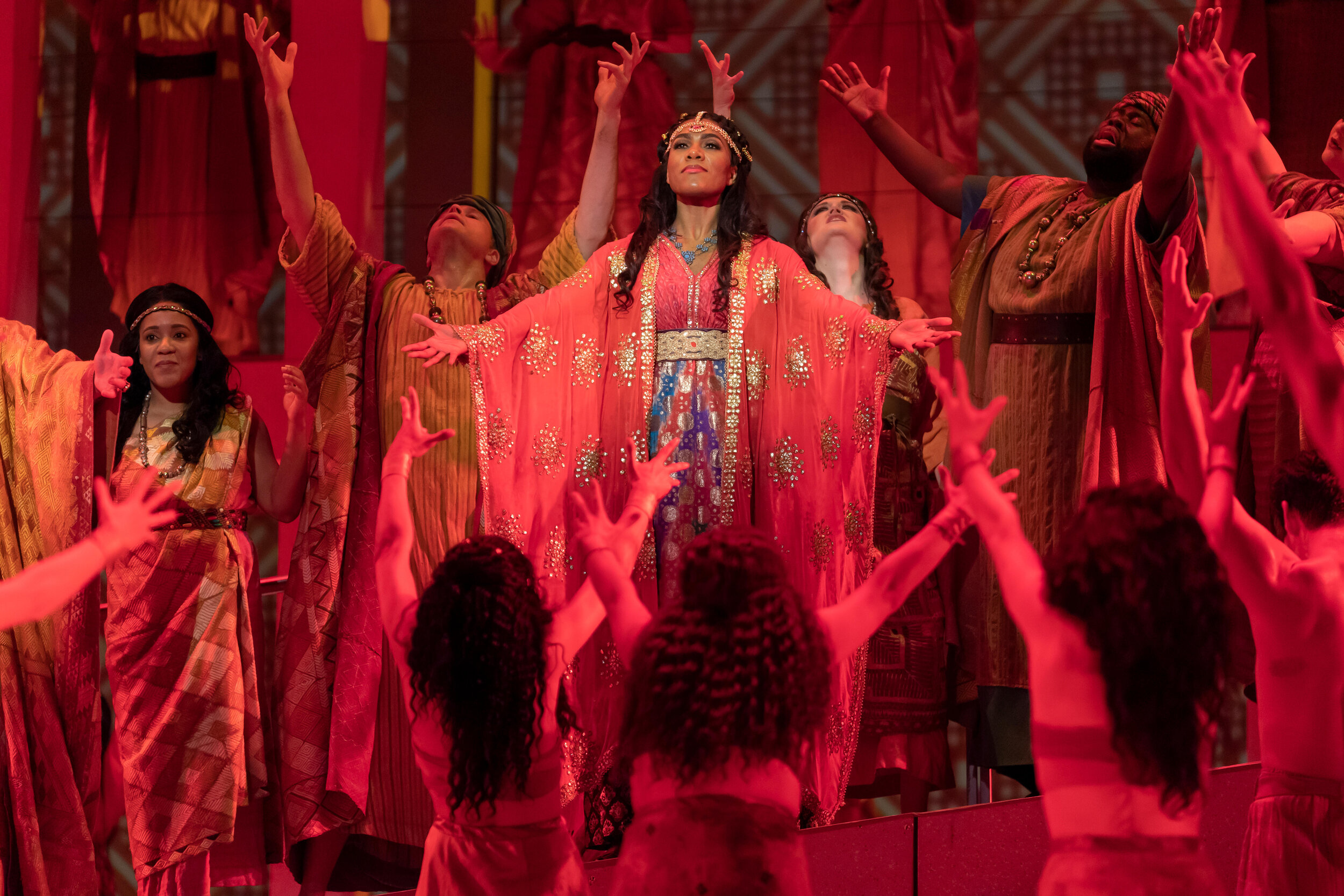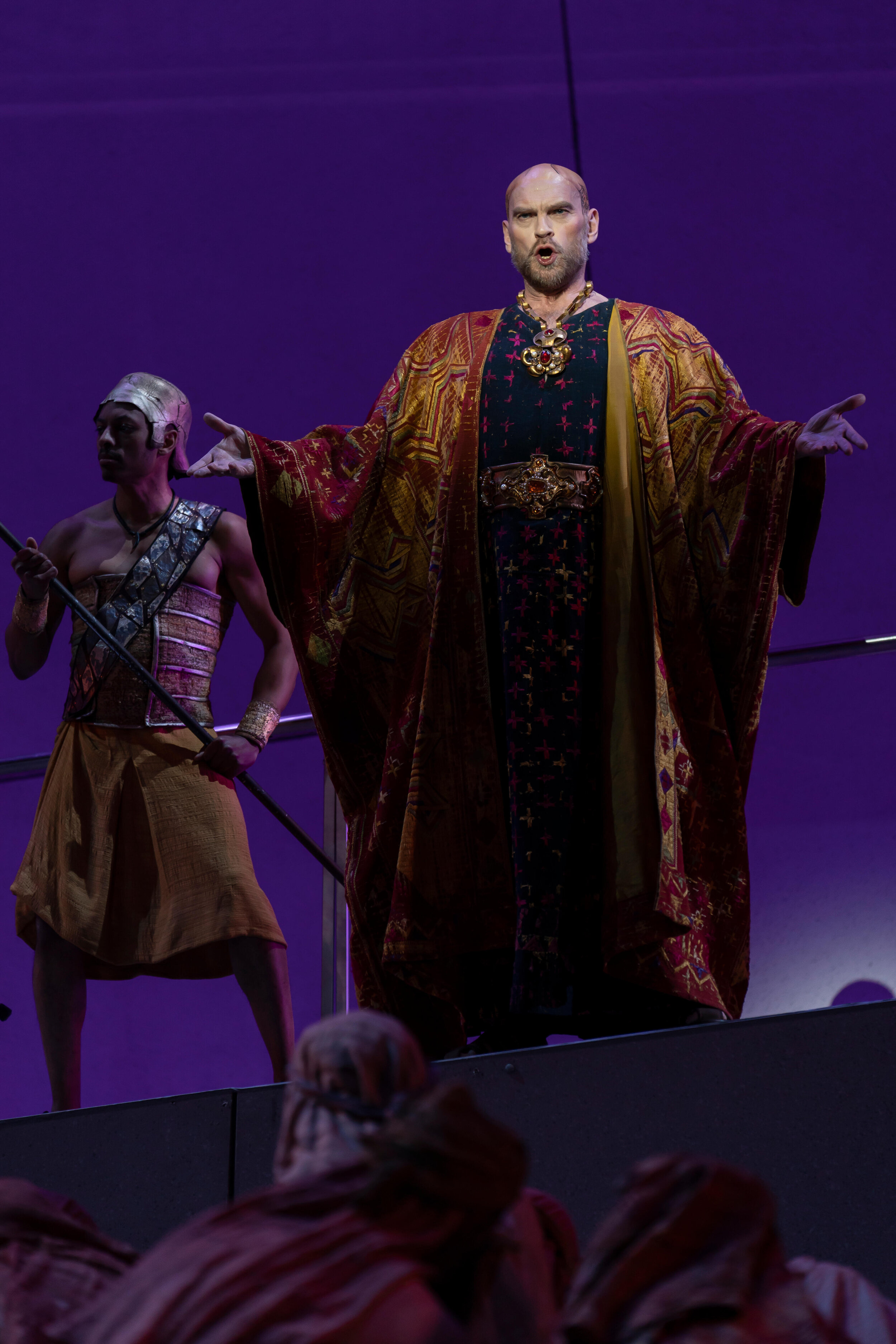Take a Bible story many of us learned in Sunday school, a couple of star performers, and a talented, creative staff in charge of the set, staging, and modern twenty-first century lighting and projection technology and you might get a Hollywood blockbuster of a movie, or if you use Camille Saint-Saéns’ grand opera, Samson and Delilah, you’d come pretty close to the same thing on stage, and while I’m thinking along those lines, Washington National Opera’s headliners, Bridges and Aronica, would make a pretty good Hedy Lamarr and Victor Mature.* So, the bottom line is that WNO’s production is a darn good show that’s as fun as popcorn and candy and a little more filling, but not a lot. And while I’m digressing, it is too bad that WNO doesn’t broadcast some of its operas into theaters like the Met does; this one would really be good with popcorn and candy.
The Old Hebrew (Peter Volpe) warns Samson (Roberto Aronica) to avoid Delilah (J’Nai Bridges), who is listening in the background. Photo by Scott Suchman; courtesy of Washington National Opera.
The story is taken from the tale of Samson in the Old Testament’s Book of Judges but focuses on Chapter 16, his seduction and destruction by Dalilah. The opera does not provide much background on Samson, except that he is the champion and inspirational leader of the Israelites, who are being ruled and oppressed by the Philistines in ancient Canaan. We know little about Delilah, except that she follows the god Dagon and sides with the Philistines. She feigns love for Samson, whom in reality she despises, and uses his love/lust for her to learn the secret of the extraordinary strength that God has given him in return for his vows of service – the secret is his uncut hair. She clips his hair, and the Philistine soldiers are able to subdue and blind him. In the end, Samson repents; God restores his strength, and, in this telling, God brings the Temple roof down killing all the Philistines inside. Like with most Bible stories, we are to look at the central messages of the story and not look too closely at the details. Questions that modern audiences might want to know more about, such as what turned Dalilah into the woman she was or is it really okay to kill all the Philistines in the Temple, are not explored. Eat your popcorn and enjoy the movie; this is artistic entertainment with a message, not a class in ethics.
Roberto Aronica as Samson and J’Nai Bridges as Delilah. Photos by Scott Suchman; courtesy of Washington National Opera.
Composer Camille Saint-Saëns was a musical prodigy along the lines of Mozart and though the body of his work that is played today is considerably less, his works are highly regarded. Of his dozen operas, only Samson and Delilah (1877) is performed today. But I suppose that is like saying that as a baseball pitcher you only pitched one no-hitter in the major leagues; it is still impressive. It is generally regarded that he was outstanding at music but not great at picking and handling subject matter. He hooked up with librettist Ferdinand Lemaire to write an oratorio on the Samson story, and Lemaire convinced Saint-Saëns to make it an opera; it nevertheless retains aspects of oratorios such as the substantial use of a substantial choir. The Paris Opera was not accepting operas based on biblical subjects at the time, but his friend Franz Liszt, who wanted to support and encourage Saint-Saëns, premiered the opera in Weimar, Germany. It was 1892 before the Paris Opera was willing to produce it, and in the 1890s, the opera became a substantial success in other cities. I think the music is terrific; it is sung without dialog or recitative and has several very strong arias. It is a grand opera in the Paris tradition – grand themes of freedom and patriotism important to the French people, lots of people on stage, dancing, a colorful spectacle.
Samson (Roberto Aronica) resists telling Delilah (J’Nai Bridges) the secret of his power. Photo by Scott Suchman; courtesy of Washington National Opera.
Samson and Delilah also serves as a star vehicle for a tenor and a mezzo-soprano, and WNO provided two who fit the roles beautifully. Rising young star, J’Nai Bridges, made a stunning and entirely believable Delilah. Her voice has a beautiful tone, especially in her low range, and she sang with impressive control in her important arias, such as “Mon coeur s’ouvre à ta voix” in Act II, which becomes a duet with Aronica near the end. I expected as much, but what surprised me about her performance was the impressive way she moved on stage and the confidence she displayed; every move and expression on her face seemed perfectly choreographed to reflect the charm of a seductress, even occasionally moving with the professional dancers. I was not familiar with tenor Roberto Aronica who played Samson, but he gave an outstanding performance both acting and singing. I’ve always wondered why Saint-Saëns chose a tenor for this role, but Aronica’s power in his mid-range seemed to fit the role very well. The supporting singers were also impressive, including baritone Noel Bouley as the High Priest of Dagon who colludes with Delilah to learn the secret of Samson’s power, and bass-baritone Tómas Tómasson as Abimélech, in a brief appearance as a Philistine leader. Bass Peter Volpe played the role of the Old Hebrew who warns Samson not to give in to his temptation. He also is playing the role of the Commendatore in WNO’s Don Giovanni, running concurrently; I thought his bass voice was good in that role, but as the Old Hebrew I realized that it is something special.
left photo: The High Priest of Dagon (Noel Bouley) appeals to Delilah (J’Nai Bridges) for help. right photo: Philistine Govenor Ambimélech (Tómas Tómasson). Photos by Scott Suchman; courtesy of Washington National Opera.
The set, designed by Erhard Rom, was essentially the same as that used for Don Giovanni, however, this did not prove too much of a distraction given the way it was adorned. The staging of the story by Director Peter Kazaras is very well done; I found the end of Act II that works itself into a frenzy and reaches a crescendo with the cutting of Samson’s hair to be thrilling. I suppose the ending with the implosion of the Temple done using lighting and media effects is okay, but gosh darn, the little boy in me really wanted to see Samson push those pillars aside and the ceiling come crashing down; I need to go back and re-watch the movie.
Samson (Roberto Aronica) appeals to God to return his strength. Photo by Scott Suchman; courtesy of Washington National Opera.
Certainly, special kudos go Lighting Designer S. Katy Tucker and Projection Designer Ken Weiss. The special effects were artistic, sometimes spectacular, and worked to help set scenes and create moods, especially using the back wall to project abstract swirls and images of the desert sun and moon that somehow benefit the telling of the tale. And there were those eerie ghost like images on the scrim when Samson was being tortured. Also, kudos to Costume Designers Michael Scott and Tim Burrow. The costumes worked to convey the time period and especially the colorful nature of the Philistines, and give us at least a somewhat sexy frenetic bacchanal scene. Speaking of which, there was a great deal of movement during most of the opera which helped to carry the story along, and the dancers and dancing were most enjoyable; kudos to Choreographer Erick Sean Fogel. In short, the production was a feast for the eyes, a straightforward telling of the story, artistically well done. I had the feeling that this cast and crew knew what they were doing and were at the top of their game.
It was also a feast for the ears. The Washington National Orchestra under the direction of Conductor John Fiore delivered Saint-Saéns score in fine fashion. Occasionally, I couldn’t help focusing on the music alone and enjoying just that. A large chorus led by Chorus Master Steven Gathman was also a pleasure to hear; if Saint-Saéns had made Samson and Delilah an oratorio, I would still be interested in attending.
So, like I said, WNO’s Samson and Delilah is a good show with some great players and a lot of professinal polish and new stage technology. If you are among the devout, you should be able to enjoy it as a religious experience, but for most people, I think it will simply be entertainment, a good Saturday afternoon popcorn movie. I wish I could say it was coming soon to Netflix.
*Note: In case you are not a septuagenarian, I should add that Hedy Lamar and Victor Mature were the movie stars in Cecile B. DeMille’s movie version of “Samson and Delilah”. Mr. DeMille was known for Hollywood blockbusters in his day.
The Fan Experience: Samson and Delilah plays again in the Kennedy Center Opera House on March 7, 13, 16, and 21. See the Samson and Delilah webpage for information on pre-opera talks and artist Q&As.







